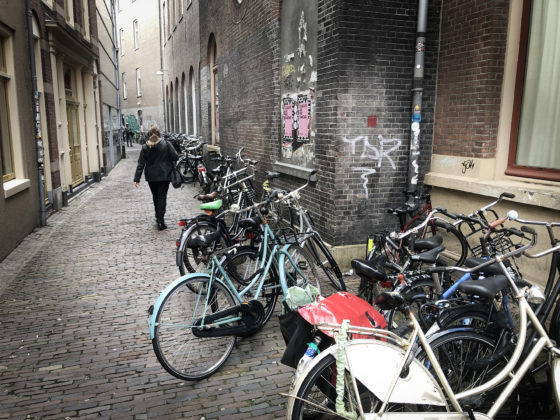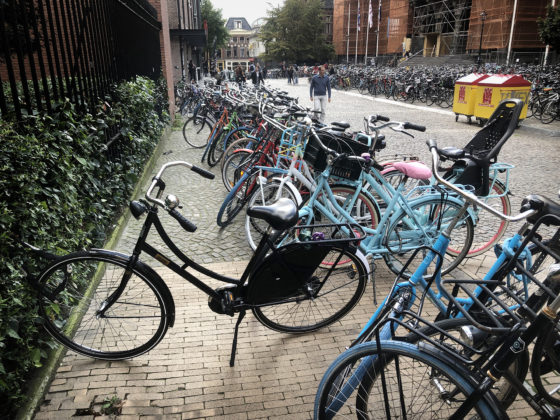
City and RUG each point to the other
The bicycle mess? Not our problem
Eva Stegeman, a student of Dutch, often crosses the Broerplei on her way to the Harmonie complex. On the corner, near Kilroy, she often runs into the mess of bikes blocking the sidewalk, and she has to step into the street. ‘I have almost been hit by cyclists once or twice’, she says.
Every day, cyclists and pedestrians jockey for space between the Harmonie building and the public library in the Oude Boteringestraat. Bicycles are parked impossibly close to each other, right next to the signs that attempt to ban people from doing so. Parents have no choice but to push their baby carriages into the street; if a car shows up, there’s basically no room to avoid it.
Law faculty service management team leader Robert Rossingh often gets comments about the situation. ‘People are angry and annoyed that they can’t walk on the sidewalk.’
Little action taken
But the worst thing is that the situation is simply unsafe. Traffic psychologist Dick de Waard has reached this conclusion as well. ‘It’s been an issue for a long time, but it’s really getting out of hand. Pedestrians shouldn’t be forced into the road because bikes are blocking the way. And what about elderly or handicapped people? It’s honestly just too much.’
It could get really dangerous in an emergency
The bikes also end up blocking emergency exits or emergency services access roads. ‘That’s not allowed, those have to stay free’, says Jan Winter, supervisor for the Groningen Safety region, a collaboration between emergency services. ‘It could get really dangerous in an emergency.’
The fire department doesn’t have much power to do anything about the situation, says his colleague Willy Lambeck. ‘It’s the building owner’s responsibility. In this case, that’s the RUG.’ He’s had discussions about it before, he says, and things improved somewhat. ‘But they can be better.’ Students should realise that they put themselves and their fellow students in danger when they park their bikes in the middle of an access road.
The Uurwerkersgang, a notorious corridor for cyclists and pedestrians
But in spite of the complaints and the warnings, the situation is not improving. According to Gerd Weitcamp with spatial sciences, where he studies mobility behaviour, it’s because there are various parties involved in the issue. ‘There’s the city on the one hand, and the RUG on the other.’
Rossingh understands what he means. ‘We try to figure things out together, but it doesn’t always work’, he says. It’s not always clear who is responsible for which patch of land. ‘The line can be really thin.’
Take the sidewalk in front of Kilroy for example, or the Uurwerkersgang. The RUG and the city each say the other is the responsible party. ‘They tell us that it’s our problem. We’re just banging our heads against the wall’, says Rossingh. He doesn’t feel like the bicyce mess issue is a priority with the city.
But urban development project manager Gijs Hoogerwerf, whose portfolio includes bicycle parking, denies this vehemently. ‘It’s very high on the coalition’s agenda. We’re definitely working on it.’
Bicycle storage
So what is the city working on exactly? Well, says Hoogenwerf, ‘we’re working on creating extra parking space for bikes.’ There will be a bicycle parking facility underneath the new Forum, with room for 1,200 bikes. The city is also considering creating a parking facility underneath the former V&D property, making room for another 1,200 bikes.
Students always park their bikes as close as possible to the buildings
But that won’t do the RUG any good. ‘Students always park their bikes as close as possible to the building they need to go to’, says Weitkamp. Now that bicycles are actively being barred from the Uurwerkersgang, they’re blocking the Harmonie square just a few metres away. Hoogerwerf thinks the solution might lie underground here, too. Except he’s not exactly sure what the best location near the university buildings would be.
The RUG is also considering turning the basement under the UB into a parking facility. It would have room for five hundred bikes. But Rossingh says it would just be a drop in the ocean: ‘It’ll hardly make a difference.’
The RUG is taking smaller actions to combat the issue as well. ‘We talk to the students’, says RUG spokesperson Jorien Bakker. ‘And we’ll continue to do so.’ Any time a student parks their bike where they’re not supposed, a bike steward will move it to a different location where it is allowed. Bakker says students know darn well where they are and aren’t allowed to park their bikes. ‘But they just don’t seem to care.’
Bicycles are parked everywhere near the UB
Stagger classes
And then we’re back to square one. Who will be taking the next step to remove the bikes or inform students? Bakker says the RUG will not be doing any of this. ‘It’s simply not our responsibility.’ There is also a parking facility underneath the public library, she adds, but students rarely want to walk the extra two minutes.
Is there nothing to be done? Will it take an accident before anyone takes action?
Weitkamp thinks the RUG and the city should get together to discuss the issue, and that they should involve students in that discussion. ‘In the end, they’re the ones parking their bikes haphazardly. If we involve them in the process, they’ll feel like we’re taking them seriously. We have to cooperate in this.’
Put a fietsflat near the university, a real landmark
Weitkamp doesn’t think a single action or even a single institution will solve the problem. Rather, it will take several smaller actions. ‘We could take a look at scheduling, for example.’ Right now, all classes start at the same time. ‘That means everyone is parking their bike at the same time as well.’ If you stagger the start times and have some classes start at nine thirty instead of nine, the parking nuisance will decrease. ‘It’s an issue of space and time.’
Another option is a fietsflat, an above ground parking facility, near one of the university properties. ‘And not just any fietsflat; make it a landmark to make the city more attractive.’ Bakker likes the idea. ‘Not that we’re currently considering it, but it might be nice for the future. Maybe on the little square next to the Academy building.’ Hoogewerf thinks it’s a good idea, but says the RUG would be responsible. ‘That’s their property, after all.’
Enforcement
Weitkamp also says the parking rules should be enforced. He feels these could be stricter, as well. ‘Just remove the wrongly parked bikes altogether. That will certainly change people’s behaviour. Just wait, in a few years, when there are all new students, the situation will have changed. So start implementing that policy now and you’ll benefit from it later.’
But who will remove the bikes when both parties keep pointing the finger at each other? ‘We have to work together’, Weitkamp reiterates.
A softer type of enforcement might work as well: it’s called nudging, influencing people without their express knowledge. The red carpets in front of the H&M store at the Grote Markt and the Korenbers are an example of nudging. ‘It’s very simple, but people know not to park their bikes on it’, says PhD student Koen Bandsma, who researched the use of nudging in public spaces.
A sign with angry eyes also helps, says Bandsma. ‘It gives people the unpleasant feeling of being watched.’ But he emphasises that nudging alone won’t be enough. ‘It only serves to support other actions.’



